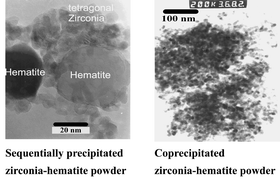Several wet chemical precipitation methods used to synthesise nanocrystalline composite powders containing zirconium oxide, yttrium oxide and iron(III) oxide are described. The crystallisation and phase composition of the precipitates were studied as a function of temperature. A co-precipitation method was compared with two different sequential precipitation routes. The amount of iron(III) oxide added varied from 27 to 42 mol% FeO1.5. The dried gel obtained after co-precipitation was extensively studied as a function of calcination temperature. After calcination for 2 hours at 600–700 °C about 10–16 mol% FeO1.5 was dissolved in the zirconia matrix. A part of the ferric oxide was present outside of the zirconia lattice, either as a crystalline hematite phase (when adding >40 mol% FeO1.5), or as a finely dispersed amorphous ferric oxide (when adding <34 mol% FeO1.5). After calcination at temperatures around 900 °C only a few mol% FeO1.5 were dissolved in the zirconia matrix. All sequential precipitation routes resulted in dual-phase yttria-doped zirconia and hematite powders after calcination. Only up to 4 mol% of ferric(III) oxide could be dissolved in the zirconia lattice when using a sequential precipitation route.

